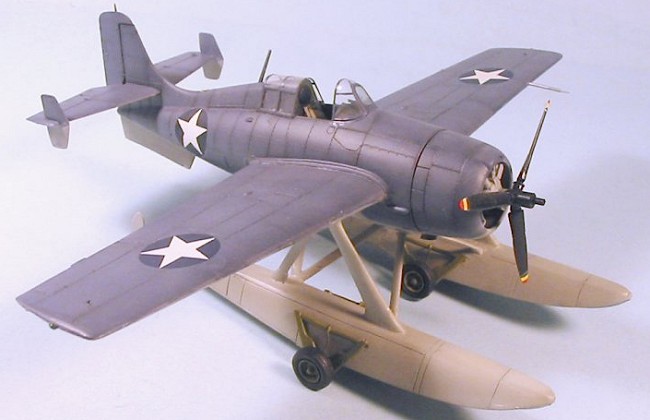
| KIT: | 1/48 F4F-3S 'Wildcatfish' |
| KIT #: | ? |
| PRICE: | $ |
| DECALS: | See review |
| REVIEWER: | Tom Cleaver |
| NOTES: | Conversion using Cutting Edge and Just Plane Stuff resin bits. |

| HISTORY |
Before the war, the Imperial Japanese Navy weren’t the only ones concerned about the provision of air power in an island campaign across the Pacific. The U.S. Navy was also well aware that between the time the troops stormed ashore and the time an airfield could be constructed, the limited number of aircraft carriers could not remain in the vicinity of the invasion as targets for enemy ships, aircraft and submarines. Fortunately for the American Navy, the solution to this problem would come by the militarization of American industrial construction methods, which led the world for ability to handle large projects at a high rate of construction. Japanese military officers after the war would state that the American ability to quickly construct airfields and port facilities was the major reason why they lost the Solomons, where they were not able to complete one new airfield in total during the entire campaign up to the capture of Bougainville in October 1943.
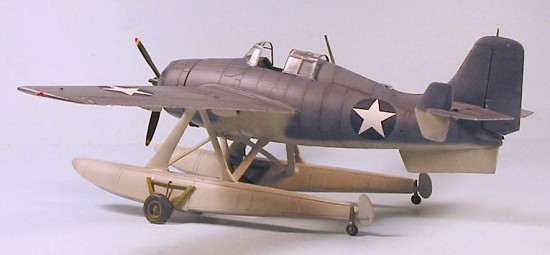 In late 1941, however, this was all in the future, and the Navy was gravely
concerned with the problem of air cover following invasion. Like the
Japanese naval air force, the Bureau of Aeronautics decided that a
floatplane fighter would be the solution. While the Japanese at first
commissioned a designed-for-the-purpose fighter - the N1K1 Kyofu (Rex) -
and then later adapted the Zero as the A6M2-N when the development of the
N1K1 slowed, the U.S. Navy decided to adapt an existing fighter from the
outset.
In late 1941, however, this was all in the future, and the Navy was gravely
concerned with the problem of air cover following invasion. Like the
Japanese naval air force, the Bureau of Aeronautics decided that a
floatplane fighter would be the solution. While the Japanese at first
commissioned a designed-for-the-purpose fighter - the N1K1 Kyofu (Rex) -
and then later adapted the Zero as the A6M2-N when the development of the
N1K1 slowed, the U.S. Navy decided to adapt an existing fighter from the
outset.
In early 1942, the Edo Corporation was contracted to convert one F3F-3 to a floatplane configuration as the F4F-3S. Unlike most Navy floatplanes, this did not have a centerline float and two wingtip floats - as did the A6M2-N - but was equipped with twin main floats. Faced with a need for such an airplane, the Navy proceeded to change a contract for 100F4F-7 long-range recon Wildcats with Grumman to an additional 100 F4F-3s.
By the time the F4F-3S flew on February 28, 1943, the Navy’s SeaBee construction battalions had proved their worth, and the program was canceled. The conversion took three months to complete. Initial flight tests revealed directional instability that resulted in the addition of a substantial ventral fin in addition to the smaller fins on the horizontal stabilizers. Top speed was reduced to 254 m.p.h., which was considered barely acceptable. The 100 F4F-3s on the production line were finished as land planes during early 1943 - the last Wildcats built by Grumman - and assigned to Training Command. This would prove fortunate for history, as the three F4F-3s ditched in Lake Michigan during the war and later recovered in the 1980s were from this batch, and now constitute the only three early Wildcats still in existence.
| THE KIT |
Over the years, modelers have been intrigued by the Wildcatfish, and during the 1970s at least two adventurous souls I knew took the Monogram Wildcat, a pair of Monogram Kingfishers, and quite a bit of scratchbuilding ability, and kitbashed Wildcatfish models.
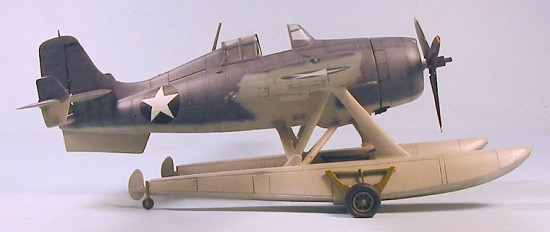 A
few years ago, Cutting Edge released a pricy conversion set to be used with
the Tamiya F4F-4, with two large resin floats and resin fins and rudders,
and white metal struts and beaching gear. This still required the modeler
to convert the folding-wing F4F-4 to a stiff-wing F4F-3, which involved
filling in the fold line and the outer gun bay in each wing, sanding those
areas smooth and then rescribing all the engraved detail. Outside of one
guy I know here in Southern California, wildcat-loving modelers took a pass
on the project.
A
few years ago, Cutting Edge released a pricy conversion set to be used with
the Tamiya F4F-4, with two large resin floats and resin fins and rudders,
and white metal struts and beaching gear. This still required the modeler
to convert the folding-wing F4F-4 to a stiff-wing F4F-3, which involved
filling in the fold line and the outer gun bay in each wing, sanding those
areas smooth and then rescribing all the engraved detail. Outside of one
guy I know here in Southern California, wildcat-loving modelers took a pass
on the project.
Three years ago, Dave Schemel created an F4F-3 conversion set for the Tamiya Wildcat, that completely replaced the wing sub-assembly of the kit with a one-piece resin wing. After using this set for a conversion, I decided to get another one, and use it with the Cutting Edge set to create a Wildcatfish.
Needless to say, at a cost of $26.00 for the Tamiya Kit, $50.00 for the Cutting Edge conversion and $40.00 for the Just Plane Stuff wing conversion, a modeler has to be extremely interested in the F4F-3S to step up to this project. I will say that, had I not received the conversion sets as review copies and the basic kit from Ed Maloney to do the model for the Planes of Fame Museum, this would likely have never been a project I would have taken on.
| CONSTRUCTION |
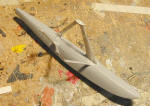 Basic construction is quite simple: assemble the Tamiya fuselage and
cockpit, and the engine and cowling as a separate assembly.
Basic construction is quite simple: assemble the Tamiya fuselage and
cockpit, and the engine and cowling as a separate assembly.
 Before attaching the Just Plane Stuff wing, I wanted to attach the floats.
Things get complicated when you proceed with attaching the floats. The
exact positioning of the struts to the floats is not that apparent in the
design of the parts, and then there is the problem of getting the struts to
attach to the airplane at the right places so that everything is the same
on both sides. This involved a lot of test-fitting, trimming, re-fitting,
re-test-fitting, wishing for a “Doc Ock” tentacle set to enable me to hold
everything in position while
Before attaching the Just Plane Stuff wing, I wanted to attach the floats.
Things get complicated when you proceed with attaching the floats. The
exact positioning of the struts to the floats is not that apparent in the
design of the parts, and then there is the problem of getting the struts to
attach to the airplane at the right places so that everything is the same
on both sides. This involved a lot of test-fitting, trimming, re-fitting,
re-test-fitting, wishing for a “Doc Ock” tentacle set to enable me to hold
everything in position while
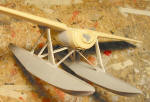 applying cyanoacrylate glue, etc.
applying cyanoacrylate glue, etc.
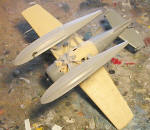 Once the floats were on and looked right, I attached the fuselage to the
assembly, and then attached the engine and cowling.
Once the floats were on and looked right, I attached the fuselage to the
assembly, and then attached the engine and cowling.
Overall, this is not a conversion for the uninitiated. The whole thing is further complicated by the fact that there are only two sets of drawings - and they are incomplete - that show this sub-type, and there were never that many photos taken of the original, and none close up. I would have to say that what finally resulted is a good approximation of the F4F-3S, that looks good on a shelf behind glass from a distance of a couple of feet or more.
| COLORS & MARKINGS |
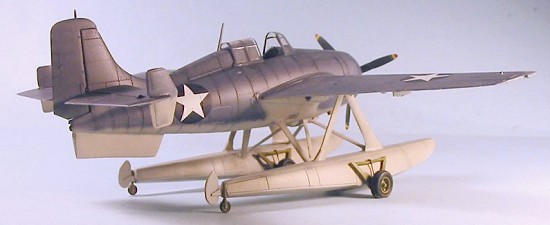 Painting:
Painting:
This was the easy part: Gunze-Sangyo Light Gull Grey for the lower surfaces and Blue-Grey for the upper surfaces, after pre-shading the model.
Decals:
Decals were fairly simple, and taken from the kit and the decal dungeon. A modeler who wanted to do a ‘what-if” model of an operational F4F-3S could have fun with this, but given there was only ever one in existence, I did that.
| FINAL CONSTRUCTION |
The prototype was kept in good condition from the photos I have seen, so I did not weather the model, but gave it a coat of Xtracrylix Flat Varnish, then attached the Squadron vacuform canopy and prop.
| CONCLUSIONS |
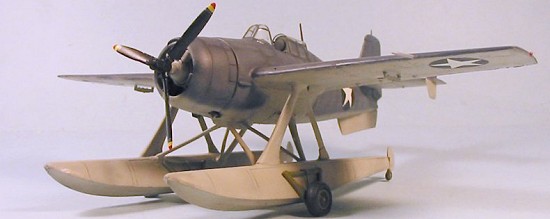 Definitely a model that gets a second look from viewers and one of only a
handful in existence. If you’re a floatplane fanatic, it’s one to get,
though be aware the project is expensive and difficult.
Definitely a model that gets a second look from viewers and one of only a
handful in existence. If you’re a floatplane fanatic, it’s one to get,
though be aware the project is expensive and difficult.
August 2005
Thanks to Cutting Edge and Just Plane Stuff for the conversion sets.
If you would like your product reviewed fairly and quickly by a site that has nearly 300,000 visitors a month, please contact me or see other details in the Note to Contributors.